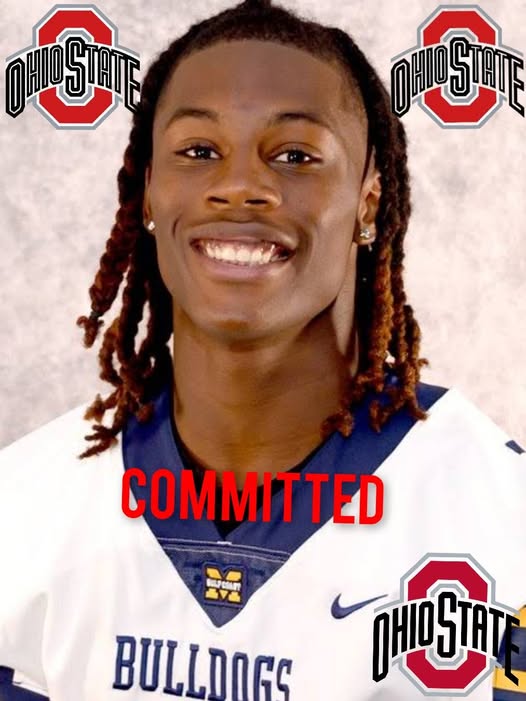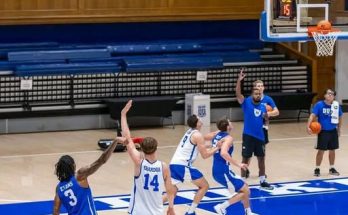The world of college football recruiting has long been a stage for high drama, with top-tier prospects often making headlines with their choices and flips. But the recent decommitment of a 5-star quarterback from the Michigan Bulldogs and his subsequent commitment to Ohio State over schools like Notre Dame and Georgia has set the recruiting world abuzz. This move is not just another recruiting flip; it’s a seismic shift in the landscape of college football. The ripple effects of this decision will be felt not only on the field but also in recruiting offices across the nation as programs adjust their strategies in the wake of this surprise.
The Shocking Decommitment: A Move That Took Everyone by Surprise
The story begins with a highly-rated 5-star quarterback, widely considered one of the best prospects in the nation. His commitment to Michigan had been celebrated by fans, and the Wolverines seemed to have secured their quarterback of the future. His decision to join the Bulldogs was seen as a major victory for Michigan’s recruiting class, bolstering their offensive plans for the coming years. He had visited Ann Arbor multiple times, built strong relationships with coaches, and seemed ready to lead the Wolverines to greatness.
However, in a move that shocked both Michigan fans and recruiting insiders, the young quarterback announced that he was decommitting from Michigan and opening his recruitment once again. This was no ordinary decommitment. His decision quickly made waves across college football, particularly as rumors began to swirl about where he would land next.
Many experts speculated that the decommitment was driven by the quarterback’s desire to explore other opportunities and to be in a program that aligned more closely with his personal and athletic goals. But no one was prepared for the twist that followed.
The Flip: Ohio State Emerges as the Top Contender
After the decommitment, the race for the quarterback’s services became a sprint between several elite programs. Michigan fans were understandably upset, especially given the amount of time and effort they had invested in securing his commitment. However, the bigger surprise came when the quarterback announced that he had committed to Ohio State over some of the best football programs in the country.
The Ohio State Buckeyes, under head coach Ryan Day, have become one of the most dominant teams in college football, consistently competing for national championships and producing high-profile NFL talent. The program’s offensive prowess, highlighted by an explosive passing attack and a history of developing quarterbacks into future pros, made it a prime destination for any top-tier signal-caller.
The decision to choose Ohio State was not just a football-related one, though. The quarterback’s visit to Columbus had been transformative. Ohio State’s state-of-the-art facilities, elite coaching staff, and culture of success were all major selling points. But beyond that, the coaching staff’s ability to develop quarterbacks into future NFL stars played a critical role in his decision. The allure of joining an offensive juggernaut like Ohio State, where quarterbacks have thrived, proved to be too much to resist.
This decommitment and subsequent flip was a painful blow to Michigan, but it also highlighted something else: the evolving nature of college football recruiting and the power of top-tier programs like Ohio State.
The Competitors: Notre Dame and Georgia Bulldogs
While Ohio State emerged victorious in the race for the quarterback’s commitment, it wasn’t without fierce competition from other elite programs. Two schools that had been heavily involved in his recruitment were Notre Dame and Georgia, and both had deep connections to the quarterback’s interests.
Notre Dame: A Historical Power in College Football
Notre Dame, traditionally one of college football’s most storied programs, was always going to be a major player in the recruitment of a player of this caliber. The Fighting Irish have been perennial contenders in the college football playoff race and boast a history of success. Under head coach Marcus Freeman, Notre Dame has established itself as a program on the rise, with a strong emphasis on player development and a culture of excellence both on and off the field.
The Notre Dame coaching staff made a concerted effort to recruit this 5-star quarterback, selling him on their vision for the future. The program’s commitment to developing quarterbacks and positioning them for success at the next level was certainly appealing. Additionally, the quarterback’s connection to Freeman and his staff was strong. However, despite all these factors, Ohio State’s offensive firepower and the prospect of playing in a more dynamic system ultimately proved more enticing.
Georgia Bulldogs: National Champions with a Strong Quarterback Development Track Record
On the other side, the Georgia Bulldogs, who had just secured a national championship and were consistently one of the most dominant teams in college football, also had a compelling pitch. Under head coach Kirby Smart, Georgia had transformed into a powerhouse, particularly on defense, but their offensive system was evolving, and the quarterback position was seen as an area of growth.
Georgia’s ability to develop top-tier talent and its national championship pedigree made it an appealing destination for any blue-chip recruit. However, with a strong class of quarterbacks already committed to the program and questions about how the offense would evolve in the coming years, the quarterback ultimately chose Ohio State, which offered the promise of a more established offensive system.
The Impact on Michigan: What Went Wrong?
Michigan’s reaction to this decommitment was understandably one of disappointment and frustration. Head coach Jim Harbaugh had worked tirelessly to secure the commitment of this 5-star quarterback, and his decision to flip to Ohio State was seen as a direct blow to the program’s recruiting efforts.
The Wolverines had built their offensive strategy around this quarterback, and his decommitment forced them to scramble for alternative options. Michigan’s staff had already put in significant work to create a relationship with this quarterback, and losing him to a rival program like Ohio State was a painful blow to their recruiting momentum.
In the aftermath of the decommitment, Michigan will likely reassess its approach to recruiting quarterbacks, focusing on building relationships and enhancing the overall experience for future recruits. It’s clear that in today’s college football world, no program is immune from losing top talent, no matter how successful they are.
Ohio State’s Recruiting Momentum: What Does This Mean for the Buckeyes?
For Ohio State, this commitment is a massive win in a year where they’re already recruiting at an elite level. The Buckeyes have consistently been in the mix for the nation’s top recruits, and securing the commitment of this 5-star quarterback further cements their status as one of the premier programs in the country.
With an established track record of developing NFL-caliber quarterbacks, including Dwayne Haskins, Justin Fields, and C.J. Stroud, Ohio State is now poised to continue its dominance at the quarterback position for years to come. This commitment will also likely influence other recruits, especially offensive players, who will look at Ohio State as the place to be if they want to showcase their talents and compete at the highest level.
The Larger Picture: How This Flip Affects College Football Recruiting
The quarterback’s decommitment and flip to Ohio State is more than just a single recruiting story; it’s indicative of larger trends in college football. The rise of the transfer portal and the increased importance of NIL (Name, Image, and Likeness) deals have reshaped the recruiting landscape, and this decision highlights the ways in which programs must adapt to stay competitive.
In today’s recruiting world, a decommitment can happen at any moment, and no commitment is truly safe until the ink is dry on national signing day. Programs are constantly adjusting their strategies, competing not just for players but for the attention and loyalty of recruits.
For Michigan, this loss serves as a reminder of the volatility of recruiting, and for Ohio State, it’s a testament to their ability to close on top targets when it matters most. The flip may be over, but the fallout from this decision will shape recruiting strategies and decisions for years to come.



